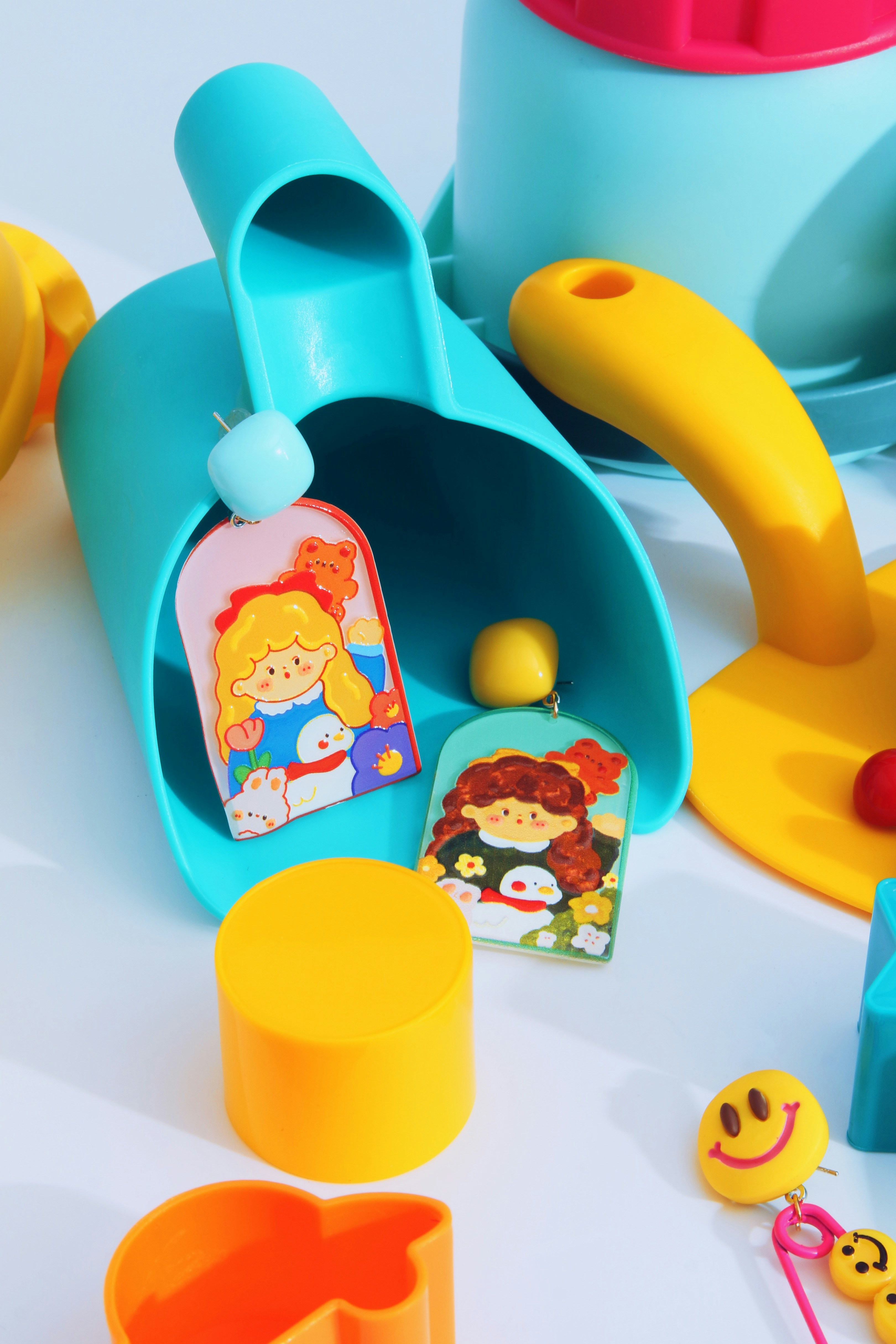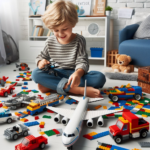
Introduction to Eco-Friendly Toys
As awareness of environmental issues grows, the demand for eco-friendly toys has seen a significant rise in recent years. Eco-friendly toys are designed with materials and processes that minimize harm to ecosystems, ensuring safety not only for children but also for the planet. These toys are often made from sustainable resources, such as organic cotton, bamboo, and recycled plastics, promoting an environmentally conscious approach to play and learning. The shift towards sustainable toys reflects a broader commitment to reducing waste and conserving natural resources.
Choosing eco-friendly toys is crucial in mitigating the adverse effects associated with traditional toy production, which can involve the use of harmful chemicals and unsustainable manufacturing practices. Parents and guardians today are increasingly recognizing the importance of selecting toys that support a healthier planet. By opting for eco-friendly alternatives, families contribute to a reduction in pollution and resource depletion, while also educating children on the value of sustainability. This promotes a more responsible future generation, aware of their ecological footprint from an early age.
The rising trend of sustainable toys in 2025 emphasizes that eco-friendly playthings are not merely a passing fad, but rather a necessary evolution in our consumer habits. Brands are stepping up by creating innovative, safe, and sustainable options that encourage creativity and imagination, all the while adhering to ethical production standards. In addition to fostering play, these toys often serve as conversation starters about environmental conservation and sustainability, nurturing a sense of responsibility in young minds. As we delve deeper into the realm of eco-friendly toys, it becomes clear that their significance extends far beyond mere entertainment.
The Benefits of Eco-Friendly Toys
Eco-friendly toys confer numerous advantages that resonate beyond mere playtime for children. Firstly, many eco-friendly toys are made from renewable materials such as bamboo, organic cotton, or recycled plastics. The use of these sustainable materials ensures that the resources utilized in manufacturing are not depleting, providing a long-term benefit for our planet. In contrast to conventional toys often constructed from non-renewable resources, eco-friendly options advocate for sustainable practices, contributing to the preservation of our natural environment.
Additionally, eco-friendly toys are typically free from toxic chemicals, making them safer for young children. Traditional toys often contain harmful substances like phthalates and heavy metals, which pose health risks to children. By choosing non-toxic toys, parents can ensure a safer play environment for their kids, promoting overall well-being.
The shift toward sustainable toys also plays a significant role in combating plastic waste. With the alarming rise in plastic pollution, eco-friendly toys provide a viable alternative. Opting for toys crafted from biodegradable or recycled materials not only helps reduce waste in landfills but also promotes a culture of responsibility among children. By teaching kids about the importance of sustainability, these toys make it easier for them to foster a connection with the environment from an early age.
Moreover, eco-friendly toys contribute positively to a child’s physical and cognitive development. Many sustainable toys encourage imaginative play and creativity, which are critical for cognitive growth. Natural materials often offer tactile experiences that can enhance sensory development. Engaging with eco-friendly toys can also prompt outdoor activities, fostering a stronger bond with nature and encouraging active lifestyles.
In summary, the diverse benefits of eco-friendly toys extend to the safety of children, the reduction of plastic waste, and the promotion of environmental consciousness. As families make conscientious choices in purchasing toys, they not only support their children’s development but also contribute positively to the planet’s future.
What Makes a Toy Eco-Friendly?
When assessing the eco-friendliness of toys, several key criteria come into play. First and foremost, the materials used in the production of a toy are crucial. Eco-friendly toys are often made from biodegradable, recycled, or renewable materials, which contribute to lesser environmental impact. For instance, toys made from sustainably sourced wood or organic cotton significantly reduce the carbon footprint associated with plastic manufacturing and promote a healthier planet.
Alongside materials, manufacturing practices play an integral role. Eco-friendly toys are typically produced in facilities that adhere to ethical principles, including fair wages and safe working conditions for employees. In addition, carbon-neutral manufacturing practices are becoming increasingly popular among sustainable brands, as they strive to minimize greenhouse gas emissions during production. This not only benefits the workers but also helps in preserving the environment.
Another important aspect is the design philosophy of the toys themselves. Eco-friendly toys are often designed with longevity in mind, encouraging durability and multi-functionality rather than planned obsolescence. Such toys promote sustainability by discouraging waste and ensuring that products are not discarded after brief use. This fosters a culture of conscious consumption, whereby children learn the value of taking care of their belongings and understand their environmental impact.
Additionally, brands that offer eco-friendly toys often incorporate educational elements that raise awareness about sustainability and environmental issues. These toys can foster creativity and curiosity in children while instilling values related to caring for the planet. By understanding these criteria, consumers can identify genuine eco-friendly toys, distinguishing them from mere marketing strategies that lack substantial eco-conscious practices.
Top Sustainable Toy Brands to Watch in 2025
As the demand for eco-friendly toys continues to rise, several brands are leading the way with innovative approaches to sustainability. In 2025, these top sustainable toy brands not only focus on the environment but also promote educational, imaginative play for children. Each brand showcases its commitment to environmentally responsible practices while ensuring that their products are both safe and fun.
One of the noteworthy brands making waves is Green Toys, renowned for its use of recycled materials in its toy production. The company sources 100% recycled plastic, primarily from recycled milk jugs, creating durable and colorful toys such as trucks, kitchen sets, and beach gear. Green Toys emphasizes safety by ensuring that its products are free from BPA, phthalates, and PVC, aligning with their mission to provide eco-friendly toys that prioritize children’s health.
Another prominent player in this market is Toybox, which takes a unique approach by integrating technology with sustainable practices. Toybox focuses on creating biodegradable toys that are powered by renewable energy during production. Their innovative products, which include interactive learning kits and eco-puzzles, incorporate sustainable materials and packaging, minimizing their carbon footprint significantly.
Hape is also a brand worth mentioning; committed to ethical toy production, it uses sustainably sourced wood and non-toxic finishes. Hape’s educational toys aim to stimulate creativity and cognitive development in children while ensuring environmental respect. The brand’s commitment to using non-toxic and organic materials differentiates it in the industry as families increasingly seek safer options for their kids.
Moreover, brands like PlanToys emphasize sustainability through their production methods, which incorporate rubberwood and adhere to eco-friendly practices. With a range of wooden toys designed to inspire imagination and learning, PlanToys sets a benchmark in contributing positively to the environment by using sustainable resources. Parents looking for educational and eco-friendly toys would benefit greatly from considering these leading brands in 2025.
Popular Eco-Friendly Toys for Every Age Group
Selecting eco-friendly toys for children is more crucial than ever. These sustainable options not only minimize environmental impact but also support healthy development through play. Below is a curated list of popular eco-friendly toys segmented by age group, highlighting their benefits and sustainable features.
Infants (0-12 months): One noteworthy option for infants is wooden stacking rings made from sustainably sourced wood. These rings are painted with non-toxic, water-based paints, ensuring that they are safe for little ones to explore. Stacking toys encourage fine motor skills and hand-eye coordination during these formative months.
Toddlers (1-3 years): For toddlers, consider a set of organic cotton stuffed animals. These plush toys are filled with hypoallergenic materials and produced in a fair-trade environment. They not only provide comfort but also promote imaginative play. Organic cotton is grown without harmful chemicals, making it a safer choice for children.
Preschoolers (3-5 years): A popular eco-friendly toy among preschoolers is the play kitchen crafted from reclaimed wood. This set allows for creative role-playing and enhances social skills. Use of reclaimed materials in its construction significantly reduces waste and promotes recycling, thus contributing to environmental sustainability.
Older Children (5+ years): For older children, consider construction sets made from recycled plastic. These sets foster creative thinking and engineering skills, all while being environmentally responsible. The use of recycled materials helps reduce plastic waste, aligning with the values of sustainability and creativity in play.
By choosing these eco-friendly toys suited for each age group, parents and gift-givers can engage children in meaningful play while instilling values of sustainability and environmental responsibility. Each toy listed not only supports a child’s development but also reinforces the importance of caring for the planet.
DIY Eco-Friendly Toy Ideas
Creating eco-friendly toys at home is not only an enjoyable and bonding activity for parents and children but also an opportunity to promote sustainability and creativity. There are several simple yet engaging DIY projects that utilize materials which may otherwise be discarded, turning them into delightful toys that inspire imaginative play.
One popular project involves creating a set of stacking blocks from cardboard boxes. Parents can collect empty cereal boxes, shoe boxes, or other sturdy materials. By cutting them into different shapes and sizes, children can help decorate them with non-toxic paints or markers, fostering artistic expression. These blocks can be used for building various structures, stimulating spatial awareness and fine motor skills.
Another creative idea is making sock puppets. Old, mismatched socks can be transformed into colorful puppets with just a few craft supplies. Parents can provide buttons, yarn, and fabric scraps for children to use as eyes, hair, and clothes. This not only encourages storytelling and role play but also teaches kids about reusing materials that would otherwise end up in landfills.
Additionally, you might consider crafting homemade musical instruments. For instance, filling plastic containers or jars with rice or beans can create shakers, while empty paper towel rolls can be turned into either flutes or maracas. These instruments offer an excellent introduction to sound exploration, rhythm, and music appreciation.
Finally, upcycling plastic bottle caps into board games can be both enlightening and entertaining. By painting the caps and constructing a simple game board made of recycled cardboard, children can engage in critical thinking and strategic play. Each of these DIY projects demonstrates the joy of crafting eco-friendly toys while teaching children the importance of recycling, thereby nurturing a thoughtful approach toward their environment.
The Role of Eco-Friendly Toys in Education
Eco-friendly toys play a significant role in children’s education, serving not only as instruments for play but also as tools for developing critical skills. These toys are often designed with an emphasis on sustainability, using natural materials that promote environmental awareness among young users. When children engage with eco-friendly toys, they are exposed to concepts of sustainability and responsibility, fostering a sense of stewardship for the planet from an early age.
One of the critical educational benefits of eco-friendly toys is their ability to enhance problem-solving skills. Many sustainable toys encourage open-ended play, allowing children to explore various solutions to challenges presented in their play environment. This kind of creative play stimulates cognitive development while reinforcing the importance of thinking critically about their actions and the materials they use.
Additionally, eco-friendly toys often promote teamwork and collaboration. By involving children in activities that require cooperative play, these toys can teach valuable social skills and the importance of working together towards a common goal. For instance, building blocks made from sustainable materials can be used in groups, helping children learn to share ideas, communicate effectively, and respect differing perspectives.
Integrating eco-friendly toys into educational curriculums can further enhance their benefits. Teachers and parents can utilize these sustainable play items to introduce lessons about ecology, resource conservation, and the life cycle of natural materials. By incorporating eco-friendly toys into both classroom and home learning environments, caregivers can ensure that children are not only learning but also developing a connection to nature and understanding the consequences of their actions.
In conclusion, eco-friendly toys serve as powerful educational tools, promoting essential skills such as problem-solving, teamwork, and environmental responsibility. The integration of these toys into various learning contexts offers children the opportunity to engage both intellectually and emotionally with their environment, laying the foundation for a sustainable future.
Tips for Choosing Eco-Friendly Toys
When it comes to selecting eco-friendly toys, parents and guardians can make informed choices that benefit both children and the planet. Understanding the labels on toys is essential. Look for terms such as “non-toxic,” “biodegradable,” or “certified organic” printed on the packaging. Such labels indicate that the materials used are safer for children and have a lower environmental impact. A variety of certifications may also guide your purchases; for example, the Forest Stewardship Council (FSC) mark ensures that wood products come from responsibly managed forests, while the Global Organic Textile Standard (GOTS) is a reliable indicator for organic fabric toys.
It is advisable to prioritize brands that exhibit a transparent approach about their manufacturing processes and sourcing. Doing a bit of research on the company can help you ensure that they are committed to sustainability and environmentally-friendly practices. Furthermore, many brands now highlight their eco-friendly initiatives on their websites, making it easier to find information directly. Joining local parent forums or social media groups focused on sustainability can also facilitate valuable discussions on the best eco-friendly toy brands.
Shopping locally is another effective way to support sustainability. Choose stores that source their products from local artisans or manufacturers dedicated to sustainable practices. Buying locally not only reduces the carbon footprint associated with transportation but also supports small businesses in your community. Understanding your buying power is crucial; consumer choices can significantly influence manufacturing practices and encourage companies to adopt more eco-conscious methods. As you encourage your children to play with eco-friendly toys, you are simultaneously promoting a culture of awareness and responsibility toward the environment.
Conclusion: The Future of Sustainable Play
As we reflect on the increasing significance of eco-friendly toys, it is evident that the movement towards sustainable play is not merely a trend but a necessary shift in consumer behavior and manufacturing practices. Today’s parents and caregivers are becoming more conscious of the environmental implications of their purchases, opting for toys that not only entertain but also promote a healthier planet. The rise of sustainable toys represents a collective acknowledgment of the responsibility that both consumers and companies bear in preserving the environment for future generations.
The decision to support brands that prioritize sustainability can drive significant change within the toy industry. As awareness grows about the adverse effects of traditional toy production, including the use of non-biodegradable plastics and harmful chemicals, demand for eco-friendly alternatives increases. This ongoing advocacy for environmentally responsible toys has led to an inspiring array of options that are not only safe for children but also gentle on the Earth. Companies that embrace eco-friendly materials, such as bamboo, recycled plastics, and organic textiles, fulfill a vital role in this evolution of playtime.
Moreover, the power of consumer influence has never been more pronounced. When individuals choose eco-friendly toys, they signal to manufacturers the importance of sustainability. This encourages innovation and the development of new, sustainable products. By making informed choices, consumers can contribute to a ripple effect that promotes environmental stewardship across various industries. Encouraging children to engage with sustainable toys also fosters a sense of responsibility towards nature from an early age, cultivating a mindful generation of consumers and caretakers of the planet.
In conclusion, the future of play hinges on our commitment to sustainability. As we continue to advocate for eco-friendly toys, we can shape a healthier, more sustainable environment for our children and the world they will inherit. Let us make conscious choices and support brands that align with these values, ensuring a positive impact on our planet for generations to come.






